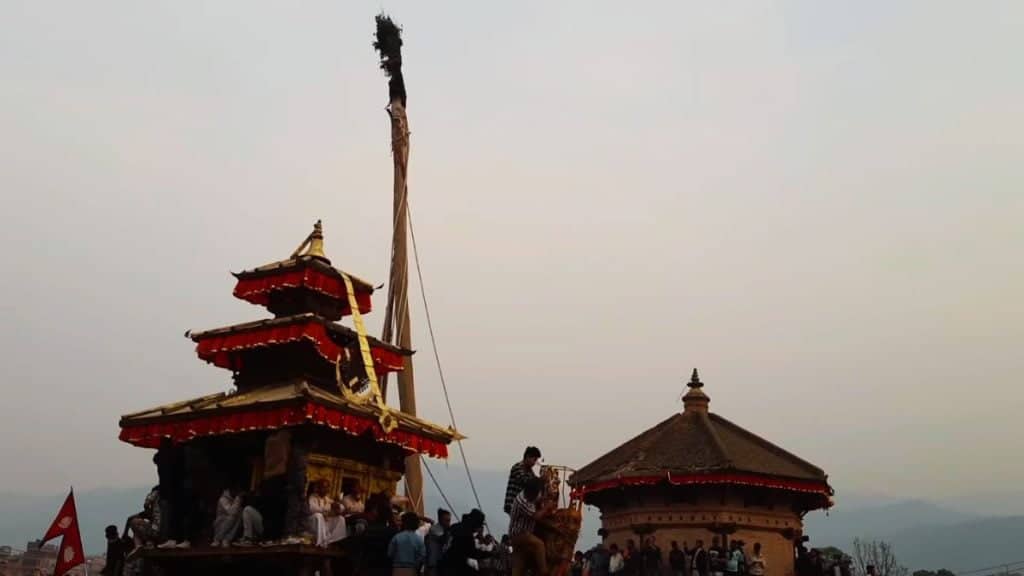Nepali New Year falls in March or April and is celebrated most enthusiastically in Bhaktapur, where it’s known as Bisket Jatra. Bisket (also known as Biska jatra) is a New Year in Nepali calendar, it is celebrated at Baisakh 1st, day of the year on Bikram Sambat (B.S.) Calendar.
The celebration of Bisket jatra is assumed to be because of Serpent ‘s death. The festival, however is not related to Bikram Sambat, according to history and passed on stories.

The highlight of the festival is the parade of chariots: one houses Bhairav; the other the goddess Bhadrakali. The chariots lumber through the streets, pause for a tug of war between the east and west parts of town, before descending to a field beside the river, where a 25-m (82-ft) wooden lingam is erected and then sent crashing down.
The New Year officially begins with the fall of the lingam. The pennants that flutter from the top of the lingam represent two snakes that were vanquished from a princess of Bhaktapur by a visiting prince who was a manifestation of Bhairav.
Story: Why is Bisket Jatra Celebrated
It is told that there was a kingdom where everyday a new king was to be selected as one dies as he sleeps a night with queen.
One day a person from unknown village came to that kingdom, locals selected him to be their king, unknown of the fact that a king dies very night he sleeps with queen, he accepts the proposal and be the king of that kingdom.
The day went off, king and queen were then off to sleep, king could not sleep thinking how and why he became king of that kingdom suddenly. While he was thinking all these, he heard some sound.
He focused himself on the sound and came to know that the sound was being produced from nostril of queen. He was amazed to see two serpents coming out of her nostrils, these serpents tried to kill the king, he fought bravely and killed both of them.
The very next day, locals came to the palace to take the body of king but was surprised to find him alive. Locals and king shared their experience and then they took the lying body of serpent and hung it on tallest available tree at middle of the city.
Same procedure is repeated annually at Bhaktapur. At the same time, the chariot carrying the god Bhairav is drawn to Bhaktapur. Similarly, Sindur Jatra is celebrated at same occasion.

Who started Bisket jatra in Bhaktapur?
The Bisket Jatra in Bhaktapur, Nepal is an annual event celebrated by the Newar community. The festival is initiated by worshipping at the Bhairabi temple near the Paanchtale temple in Naumadi. The Newars have a historical tale that links the festival’s start to the worship of these temples. King Jagjyoti is also mentioned in some sources for his connection to the festival. However, the precise individual who started the Bisket Jatra is not explicitly mentioned in the provided search results. It appears that the festival’s origins might be a blend of historical events, local traditions, and religious practices.
When Bisket Jatra is Celebrated
Celebrated by: Generally Celebrated by Newars from Bhaktapur, Tokha, Thimi and minorly on other places of Nepal
Celebrated at: 1st of Baisakh, Bikram Sambat Calendar
You may also like to read Ramanavami Festival
How is Bisket Jatra celebrated in Bhaktapur?
Four days before 1st Baisakh, the Chariot of god Bhairav is pulled, it is like a competition where people from two sides, thwane (upper) and kwane (lower) energetically try to pull the wooden chariot. The chariot is made with wood and stitching in about a month.
Next two days are like inactive days where people go to various temples and worship for better next year and pray for peace and prosperity. On a day before 1st Baisakh, lingo is erected at two places of Bhaktapur.

Lingo is a holy wooden pole, cut out from a salla tree. First lingo is erected at Pottery Square (Talako) at morning time.
The temple near by ‘Jyatha Ganesh’ is first worshiped in the morning and the holy wooden pole is dragged to the location where it is erected, after worshiping the wooden pole, it is erected with the help of cross stands and ropes being pulled by numbers of devotees.
Later that day, at evening another lingo is erected at Yosinkhel after the Chariot of Bhairav and Bhadrakali reaches at Yosinkhel, serpents as stated on the introduction are displayed at this place.
At this night, worship is done in a number of temples and people stay all night awake and worship god and goddess.
The next day, 1st of Baisakh, lingo from Yosinkhel is grounded, devotees visit these sacred places to worship playing Dhyama and other local musical instruments.
Next day gods and goddesses are taken from their resting place and are roamed around their territory.
At 4th of Baisakh, Dyo sagun is given at almost each and every temple in Bhaktapur Municipality.
The next day, i.e. 5th of Baisakh, lingo from Talako is grounded, the same night chariot and other god/goddess are restored in their own place and thereby ends the festival.

